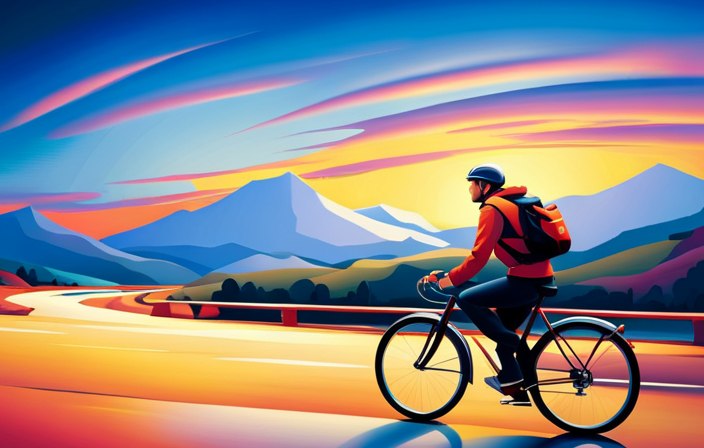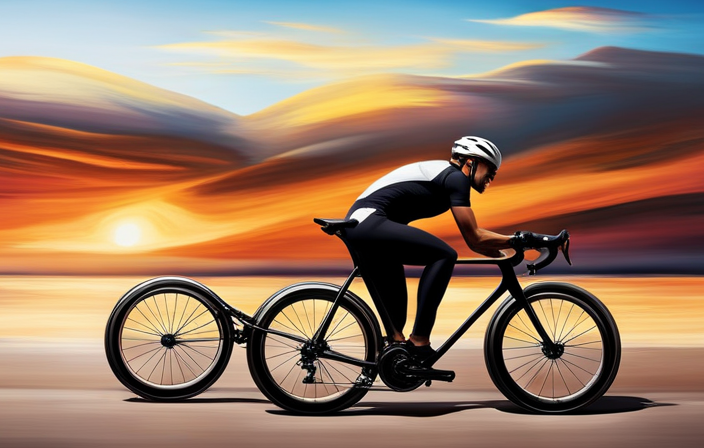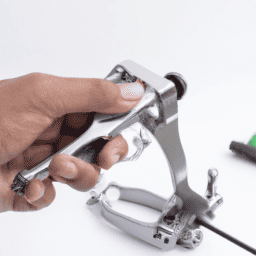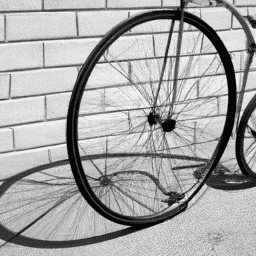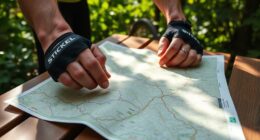Are you aware that motorized bikes are gaining popularity? By blending pedal power with motorized support, these innovative vehicles provide a distinctive and convenient way of getting around.
In this article, I will explore what exactly a motorized bicycle is, its features and components, the different types available, and the benefits of owning one.
Additionally, we will discuss the legal requirements, maintenance tips, safety precautions, and answer common FAQs.
So, let’s dive in and discover the exciting world of motorized bicycles!
Key Takeaways
- Motorized bicycles are evaluated based on performance, comfort, and suitability through research and test rides.
- Maintenance and care for motorized bicycles include checking tire inflation and wear, cleaning and lubricating the chain, and inspecting and adjusting brakes.
- Safety tips for riding a motorized bicycle include wearing appropriate gear, being aware of road and traffic conditions, and following traffic laws.
- Motorized bicycles offer advantages such as zero emissions, efficient transportation, and advancements in technology for better performance and sustainability.
Definition of a Motorized Bicycle
A motorized bicycle is a type of vehicle that you can ride, which is equipped with an engine to provide power and assistance while pedaling. This means that you can still use the pedals to move the bike forward, but the engine will give you an extra boost.
The definition of a motorized bicycle can vary depending on the country or state, but generally, it is considered to be a bicycle with an engine that has a maximum power output limit.
There are several advantages to using a motorized bicycle, such as increased speed and range, reduced effort required for pedaling, and the ability to tackle hills and inclines with ease.
Now, let’s move on to the features and components of a motorized bicycle.
Features and Components of a Motorized Bicycle
One important feature of a motorized bicycle is its engine, which provides power for propulsion. Motorized bicycle engines come in various types, each with its own benefits and drawbacks.
One common type is the two-stroke engine, which is lightweight and compact, making it suitable for smaller motorized bicycles.
Another type is the four-stroke engine, which is more fuel-efficient and produces less noise and pollution. When choosing a motorized bicycle engine, it is important to consider factors such as power output, fuel consumption, and ease of maintenance.
In addition to the engine, motorized bicycle accessories play a crucial role in enhancing the functionality and comfort of the ride. These accessories can include headlights, tail lights, mirrors, cargo racks, and even electric start systems.
Transitioning into the next section about types of motorized bicycles, it is important to consider the various options available for customization and personalization.
Types of Motorized Bicycles
When considering types of motorized bicycles, you have a range of options to choose from.
There are several motorized bicycle modifications that can enhance your riding experience. One popular modification is adding an electric motor to a regular bicycle frame, giving you the option to pedal or use the motor for assistance.
Another option is a gas-powered motorized bicycle, which provides more power and speed compared to electric models. Additionally, there are motorized bicycles specifically designed for off-road use, with features like rugged tires and suspension systems.
In terms of accessories, popular options include bike lights, cargo racks, and bike locks to ensure safety and convenience. These modifications and accessories allow riders to customize their motorized bicycles according to their specific needs and preferences.
Transitioning into the benefits of owning a motorized bicycle, let’s explore how these versatile vehicles can improve your daily commute and recreational activities.
Benefits of Owning a Motorized Bicycle
Imagine how much easier and faster your daily commute or recreational activities could be with the added convenience and speed of a motorized bicycle.
There are several advantages to owning a motorized bicycle. Firstly, it allows you to cover longer distances without getting tired, as the motor provides assistance when pedaling. This can be especially beneficial if you have a hilly commute or if you struggle with physical exertion.
Additionally, a motorized bicycle can save you money on fuel costs, as they are generally more fuel-efficient than cars or motorcycles. However, there are some drawbacks to consider. Motorized bicycles may require regular maintenance and repairs, and they may not be suitable for all terrains or weather conditions. Nonetheless, the benefits of owning a motorized bicycle can greatly outweigh the drawbacks.
Transitioning into the next section, let’s now explore the legal requirements and regulations for motorized bicycles.
Legal Requirements and Regulations for Motorized Bicycles
Let’s now delve into the legal requirements and regulations for owning a motorized bike.
When it comes to legal requirements, it’s essential to know that each country and state may have its own set of rules. In general, motorized bicycles may need to meet certain criteria to be considered road legal. These criteria can include engine size limitations, maximum speed restrictions, and requirements for lights, reflectors, and brakes.
Additionally, riders may need to obtain a specific license or permit, wear protective gear, and follow traffic laws. Safety regulations are also crucial to ensure the well-being of both the rider and others on the road. These regulations can include wearing a helmet, using turn signals, and obeying speed limits.
Understanding and following these legal requirements and safety regulations are important for a safe and legal riding experience.
Now, let’s move on to the next section, which discusses how to choose the right motorized bicycle for you.
How to Choose the Right Motorized Bicycle for You
When choosing a motorized bicycle, it’s important to consider your own needs and preferences.
Think about how you plan to use the bike and what features are important to you, such as speed, range, and comfort.
It’s also a good idea to research different brands and models to find one that fits your requirements.
Lastly, don’t forget to test ride and evaluate the bike before making a purchase. This will give you a firsthand experience of how it feels to ride and whether it meets your expectations.
Consider Your Needs and Preferences
Before buying a motorized bicycle, think about your needs and preferences. There are several considerations to keep in mind when choosing the right motorized bicycle for you. One of the most important factors is the purpose of the bicycle. Are you looking for a bike for commuting, off-road adventures, or leisurely rides around town? Additionally, think about your riding style and comfort preferences. Do you prefer a upright riding position or a more aggressive one? Another important consideration is the weight and size of the bike. Will you need to transport it or store it in a small space? To help you visualize these considerations, here is a table comparing different factors to consider when choosing a motorized bicycle:
| Considerations | Comparison Shopping |
|---|---|
| Purpose | What will you use the bike for? |
| Riding Style | Do you prefer an upright or aggressive riding position? |
| Weight and Size | How easy is it to transport or store the bike? |
In order to make an informed decision, it is important to research different brands and models.
Research Different Brands and Models
To make an informed decision, you should research various brands and models of motorized bicycles.
There are several research methods you can use to gather information about motorized bicycles, such as online forums, manufacturer websites, and customer reviews.
Online forums are a great way to connect with other motorized bicycle enthusiasts and get their opinions on different brands and models.
Manufacturer websites provide detailed information about the specifications and features of each bike, allowing you to compare them side by side.
Customer reviews are valuable because they provide real-world feedback from people who have actually purchased and used the bikes.
By thoroughly researching different brands and models, you can find the motorized bicycle that best suits your needs and preferences.
This will help you make a more informed decision when it comes time to test ride and evaluate before purchasing.
Test Ride and Evaluate Before Purchasing
After conducting thorough research on different brands and models of motorized bicycles, I have finally narrowed down my options. Now, it’s time for the exciting part – test riding and evaluating the bikes before making a final purchase.
This step is crucial as it allows me to get a feel for the bike’s performance, comfort, and overall suitability for my needs. During the test ride, I will pay close attention to the bike’s handling, acceleration, braking, and stability. I will also evaluate the comfort of the seat, the ergonomics of the handlebars, and the overall fit of the bike.
By going through this evaluating process, I can ensure that I am making an informed decision and choosing a motorized bicycle that meets all my requirements.
As I move onto discussing maintenance and care tips for motorized bicycles, it is important to remember that regular upkeep is essential for keeping these bikes in top shape.
Maintenance and Care Tips for Motorized Bicycles
Regular maintenance is essential to keep your motorized bicycle running smoothly. Here are some maintenance tips and a troubleshooting guide to help you take care of your motorized bicycle:
- Check the tires regularly for proper inflation and wear.
- Clean the chain and lubricate it regularly to prevent rust and ensure smooth operation.
- Inspect the brakes and adjust them if necessary for optimal stopping power.
- Keep the engine clean by regularly wiping it down and removing any debris.
By following these maintenance tips, you can ensure that your motorized bicycle stays in good condition and performs at its best.
Now, let’s move on to the next section about safety tips for riding a motorized bicycle.
Safety Tips for Riding a Motorized Bicycle
When riding a motorized bike, it’s important to prioritize safety and follow these tips.
First and foremost, wearing the right riding gear is essential. A helmet is a must to protect your head in case of an accident. Additionally, wearing protective clothing such as gloves, long pants, and closed-toe shoes can help minimize injuries.
Second, it’s crucial to be aware of the road and traffic conditions. Always ride in the designated bike lanes or on the right side of the road, and follow traffic laws just like any other vehicle. Be cautious of car doors opening, pedestrians crossing, and other vehicles around you.
Lastly, always maintain a safe speed and be mindful of your surroundings. By being proactive and cautious, you can ensure a safe and enjoyable ride.
Now, let’s move on to the common FAQs about motorized bicycles.
Common FAQs About Motorized Bicycles
One common FAQ about motorized bicycles is whether they are legal to ride on public roads. The answer to this question varies depending on the jurisdiction. In some places, motorized bicycles are considered to be the same as regular bicycles and are allowed on public roads, while in other areas they may be classified as mopeds or motorcycles and require special licenses and registrations.
Here are some other frequently asked questions about motorized bicycles:
-
How fast can a motorized bicycle go? The speed of a motorized bicycle can vary depending on the engine size and power, but most can reach speeds of 20 to 30 miles per hour.
-
Do I need a driver’s license to ride a motorized bicycle? Again, this depends on the jurisdiction. In some places, a driver’s license is not required, while in others it may be necessary.
-
What are the advantages of using a motorized bicycle? Some advantages include increased speed and range compared to regular bicycles, the ability to tackle hills and inclines more easily, and reduced physical exertion during longer rides.
-
Are motorized bicycles environmentally friendly? Motorized bicycles can be considered more environmentally friendly than cars or motorcycles since they produce fewer emissions and require less fuel.
In conclusion, the future of motorized bicycles holds great potential for both recreational and practical use.
Conclusion: The Future of Motorized Bicycles
The future of motorized bicycles holds great potential for both recreational and practical use. Advancements in technology and increased popularity among riders are driving this potential. As technology continues to advance, we can expect to see even more efficient and powerful motorized bicycles on the market. These advancements may include improved battery life, lighter and more durable materials, and enhanced motor capabilities.
Additionally, the environmental impact of motorized bicycles is a key consideration for the future. With the growing concern for sustainability, manufacturers are likely to focus on developing more eco-friendly options. Electric motorized bicycles that produce zero emissions are a prime example. This focus on sustainability will not only benefit the environment but also provide riders with a guilt-free and efficient mode of transportation.
Overall, the future of motorized bicycles looks promising. It offers exciting possibilities for riders and a greener alternative for transportation.
Frequently Asked Questions
Can I ride a motorized bicycle on any type of terrain?
Yes, you can ride a motorized bicycle on various terrains, but there are limitations. While motorized bicycles have off-road capabilities, they may struggle with extremely rough or steep terrain. It’s important to consider the bike’s capabilities and your skill level before attempting challenging terrains.
How fast can a motorized bicycle go?
Motorized bicycles can reach top speeds of around 30 to 40 miles per hour. The speed can be influenced by factors such as engine power, weight of the rider, terrain, and wind resistance.
What is the average range of a motorized bicycle on a single charge or tank of gas?
On a single charge or tank of gas, the average range of a motorized bicycle can vary depending on factors such as terrain, weight, and engine size. However, typically it can travel around 50-100 miles before needing to refuel or recharge.
Do I need a special license to ride a motorized bicycle?
You don’t need a special license to ride a motorized bicycle. However, it’s important to consider the terrain compatibility before riding. It’s always a good idea to familiarize yourself with local laws and regulations.
Can I convert my regular bicycle into a motorized bicycle?
Yes, you can convert your regular bicycle into a motorized bicycle. The converting process involves adding a motor and a battery to the bicycle. The advantages are increased speed and less effort, but the disadvantages are cost and added weight.
Conclusion
In conclusion, motorized bicycles are the epitome of modern transportation.
With their sleek design and efficient engines, they offer a convenient and eco-friendly way to navigate the urban jungle.
Whether you’re a hipster looking to make a fashion statement or a practical individual seeking a cost-effective alternative, a motorized bicycle has got you covered.
So, hop on this two-wheeled marvel and zoom through the streets with style. Just remember to follow the rules of the road and enjoy the ride.
The future of motorized bicycles is bright, my friends!
